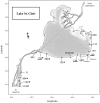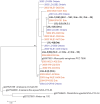Phylogenies of microcystin-producing cyanobacteria in the lower Laurentian Great Lakes suggest extensive genetic connectivity
- PMID: 25207941
- PMCID: PMC4160157
- DOI: 10.1371/journal.pone.0106093
Phylogenies of microcystin-producing cyanobacteria in the lower Laurentian Great Lakes suggest extensive genetic connectivity
Abstract
Lake St. Clair is the smallest lake in the Laurentian Great Lakes system. MODIS satellite imagery suggests that high algal biomass events have occurred annually along the southern shore during late summer. In this study, we evaluated these events and tested the hypothesis that summer bloom material derived from Lake St. Clair may enter Lake Erie via the Detroit River and represent an overlooked source of potentially toxic Microcystis biomass to the western basin of Lake Erie. We conducted a seasonally and spatially resolved study carried out in the summer of 2013. Our goals were to: 1) track the development of the 2013 summer south-east shore bloom 2) conduct a spatial survey to characterize the extent of toxicity, taxonomic diversity of the total phytoplankton population and the phylogenetic diversity of potential MC-producing cyanobacteria (Microcystis, Planktothrix and Anabaena) during a high biomass event, and 3) compare the strains of potential MC-producers in Lake St. Clair with strains from Lake Erie and Lake Ontario. Our results demonstrated a clear predominance of cyanobacteria during a late August bloom event, primarily dominated by Microcystis, which we traced along the Lake St. Clair coastline downstream to the Detroit River's outflow at Lake Erie. Microcystin levels exceeded the Province of Ontario Drinking Water Quality Standard (1.5 µg L(-1)) for safe drinking water at most sites, reaching up to five times this level in some areas. Microcystis was the predominant microcystin producer, and all toxic Microcystis strains found in Lake St. Clair were genetically similar to toxic Microcystis strains found in lakes Erie and Ontario. These findings suggest extensive genetic connectivity among the three systems.
Conflict of interest statement
Figures




References
-
- Carmichael WW (2001) Health effects of toxin-producing cyanobacteria: “The CyanoHABs”. Hum. Ecol Risk Assess 7: 1393–1407.
-
- Carmichael WW (2008) A world view-one-hundred twenty-seven years of research on toxic cyanobacteria-Where do we go from here? In: Hudnell HK, editor. Cyanobacterial Harmful Algal Blooms: State of the Science and Research Needs Series: Advances in Experimental Medicine and Biology, Vol. 619 , Amsterdam: Springer, pp. 105–120. - PubMed
-
- Hoagland P, Anderson DM, Kaoru Y, White AW (2002) The economic effects of harmful algal blooms in the United States: Estimates, assessment issues and information needs. Estuaries 25: 819–837.
-
- Hudnell HK (2008) Cyanobacterial Harmful Algal Blooms: State of the Science and Research Needs Series: Advances in Experimental Medicine and Biology, Vol. 619 , Amsterdam: Springer, 950 p. - PubMed
Publication types
MeSH terms
Substances
Associated data
- Actions
- Actions
- Actions
- Actions
- Actions
- Actions
- Actions
- Actions
- Actions
- Actions
- Actions
- Actions
- Actions
- Actions
- Actions
- Actions
- Actions
- Actions
- Actions
- Actions
- Actions
- Actions
- Actions
- Actions
- Actions
- Actions
- Actions
- Actions
- Actions
- Actions
- Actions
- Actions
- Actions
- Actions
- Actions
- Actions
- Actions
- Actions
- Actions
- Actions
- Actions
- Actions
- Actions
- Actions
- Actions
- Actions
- Actions
- Actions
- Actions
- Actions
- Actions
- Actions
- Actions
- Actions
- Actions
- Actions
- Actions
- Actions
- Actions
- Actions
LinkOut - more resources
Full Text Sources
Other Literature Sources

